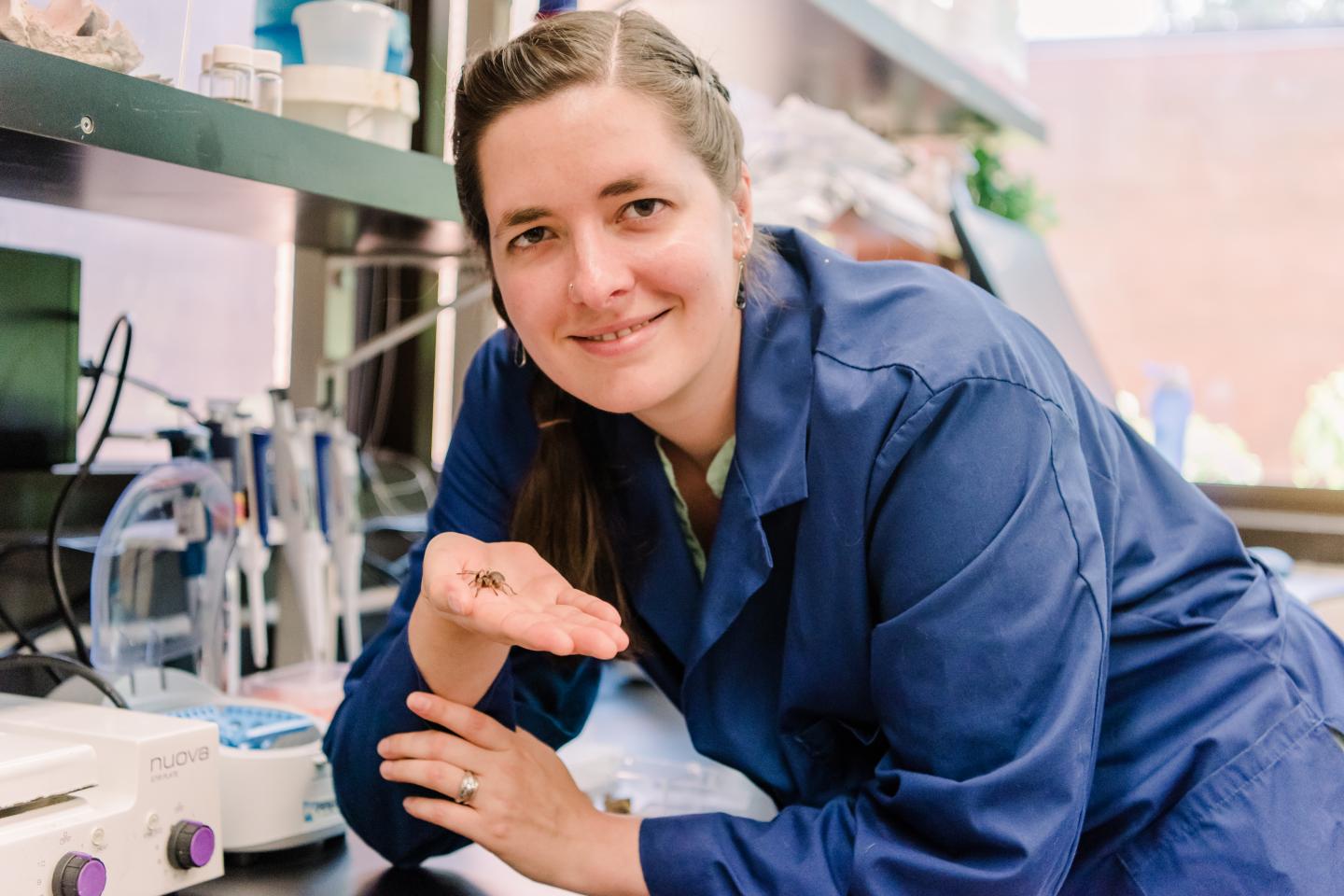Huge spider glue genes proved exceptionally challenging to sequence, could lead to organic pest control and more

Credit: Marlayna Demond for UMBC
UMBC postdoctoral fellow Sarah Stellwagen and co-author Rebecca Renberg at the Army Research Lab have published the first-ever complete sequences of two genes that allow spiders to produce glue–a sticky, modified version of spider silk that keeps a spider’s prey stuck in its web. The findings appeared in Genes, Genomes, Genetics.
The innovative method they employed could pave the way for others to sequence more silk and glue genes, which are challenging to sequence because of their length and repetitive structure. Better understanding of these genes could move scientists closer to the next big advance in biomaterials.
Sticky solutions
Spider silk is what spider webs are made of, and it’s been touted for years as the next big thing in biomaterials because of its unusual tensile strength combined with its flexibility. There are more than 45,000 known species of spiders, each of which makes between one and seven types of silk. However, despite many partial sequences, less is known about the full genetic structure of spider silk: Only about 20 complete genes have been sequenced. “Twenty pales in comparison to what’s out there,” Stellwagen says.
Plus, spider silk has proven tough to produce in large amounts. Spiders convert liquid blobs of silk into solid, spindly fibers in a complex process inside their bodies. Scientists can make the liquid, but “we can’t replicate the process of going from liquid to solid on a large industrial scale,” Stellwagen says.
Spider glue, however, is a liquid both inside and outside the spider. While the glue “does have its own challenges,” Stellwagen says, that difference might make spider glue easier to produce in a lab than silk.
Stellwagen sees great potential for spider glue applications as organic pest control. After all, she says, “This stuff evolved to capture insect prey.”
For example, farmers could spray the glue along a barn wall to protect their livestock from insects that bite or cause disease, and then could rinse it off without worrying about polluting waterways with dangerous pesticides. They could use glue similarly to protect crops from pests. It could also be applied in areas where mosquito-borne illnesses are prevalent. “It could also just be fun to play with,” Stellwagen says.
A “behemoth of a gene”
Before Stellwagen and Renberg’s work, which was funded by the Army Research Lab, the longest silk gene sequenced was about 20,000 base pairs. When she started this project, Stellwagen was expecting to sequence the glue genes quickly and then move on, building on what she learned from the sequence. Instead, it took her and Renberg two years just to finalize the sequence.
“It ended up being this behemoth of a gene that’s more than twice as large as the previous largest silk gene,” Stellwagen says. It was a long, hard road to the day she found Renberg in the lab and said, “I think our gene is 42,000 bases long. I think we finished it.” And in the end, it was taking a risk on a cutting-edge technique that finally yielded the complete sequence.
Not only was the gene exceptionally long, but, like spider silk genes, it has many repetitions of the same sequence of bases–A, T, G, and C–in the middle. Modern sequencing techniques (called “next generation sequencing”) work by generating DNA sequences for all of an organism’s genes, but chopped up in little pieces. Then, like solving a puzzle, scientists must match up the overlapping ends of the short sections to determine the entire sequence.
However, if your gene is repetitive, you need a single sequence, or “read,” that extends from before the repetitious region to beyond the end to know how many repetitions there are. If your repetitious section is long, as it is in the glue genes Stellwagen and Renberg studied, the chance that you would get the read you need with next-generation methods is slim.
Fortunately, “third-generation” sequencing techniques are now available. Third-generation sequencing produces longer reads, but fewer of them. Only by repeating the experiment several times do you have a chance of getting the reads you need to determine the number of repetitions and finally define the gene’s entire sequence. “It’s challenging,” says Stellwagen. “You’re picking a needle from a haystack.”
But it worked. After two years of going to the computer and not seeing positive results, Stellwagen and Renberg finally got the reads they needed to define the entire gene’s sequence.
Stellwagen is already thinking ahead to what comes next. “Now that we have a protocol for discovering full-length silk genes, what do silks from other species look like?” she asks.
“I’m super excited that I was able to finally figure out the puzzle, because it was just so hard,” Stellwagen says. While it was a much bigger challenge than she expected, “Ultimately we learned a lot, and I am happy to put that out there for the next person who is trying to solve some ridiculous gene.”
###
Media Contact
Sarah Hansen
[email protected]
Related Journal Article
http://dx.




